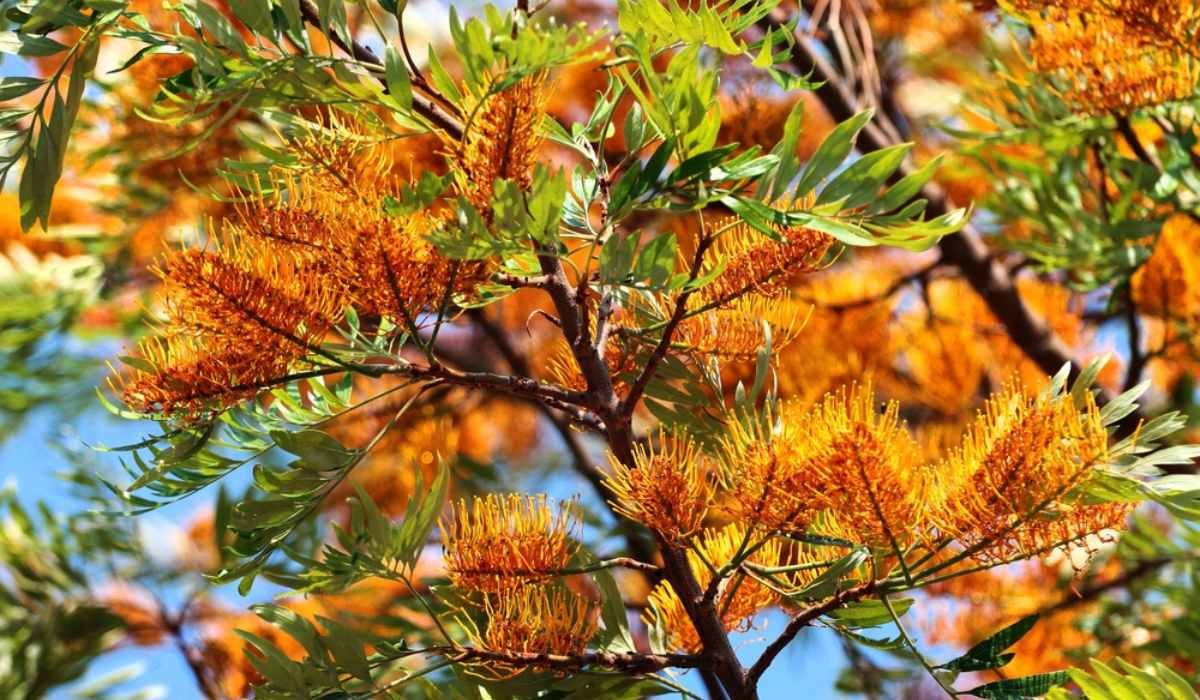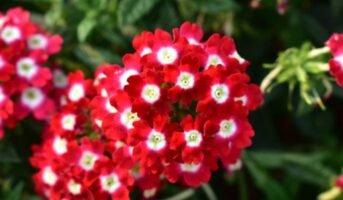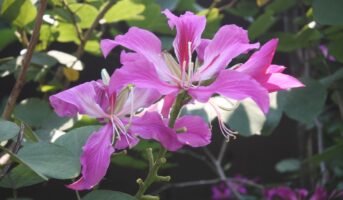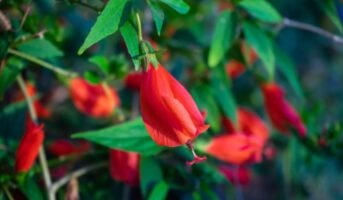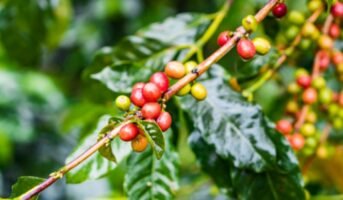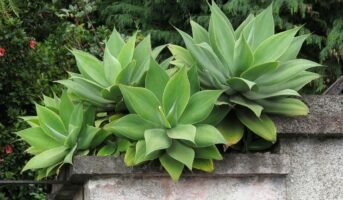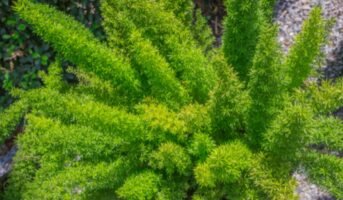Grevillea robusta is a flowering plant of the Proteaceae family, also known as the southern silky oak, silk oak, silver oak, or Australian silver oak. It grows naturally in riverine, subtropical, and dry rainforest settings in eastern coastal Australia.
In the tropics, the tree is frequently farmed for its wood and for use as a windbreak. It is a decorative plant that is cultivated both as a street tree and in gardens due to its appealing fern-like foliage and spectacular orange blossom show. In subtropical regions, the tree blooms profusely, but only sporadically in lowland tropical regions.

Source: Pinterest
Grevillea robusta: Key facts
| Common Name | Silky oak, silver oak, Australian silver oak |
| Family | Proteaceae |
| Use | Furniture |
| Native | Australia |
| Sunlight | Full exposure to sunlight |
| Soil type | Soils of high fertility |
The Genus
Native Habitat
It grows naturally in riverine, subtropical, and dry rainforest settings in eastern coastal Australia. Grevillea robusta is a native of southern Queensland and northern New South Wales in Australia, where it can be found from the east coast to 160 km inland in the Bunya Mountains in Queensland.
Sun Tolerance
The Grevillea robusta grows best in full sun but as a young plant it can have a little shade and can be grown as an indoor plant.
Mature Height
The Grevillea robusta is a fast-growing evergreen tree growing around 18- 40 m tall.
Leaves
The olive green fern like leaves of the Grevillea robusta are dark green with silverish undersides.
Crown shaft
The crown of the Grevillea robusta is long, narrow and very sparse. Conical and symmetrical in nature, the crown shaft has branches that are spaced at intervals of around 1 m.
Cold tolerance
The Grevillea robusta is frost hardy to -8 degree Celsius. This plant is grown as an annual owing to its beautiful looks.
Self pruning characteristic
Once the flowering is done, the Grevillea robusta can be pruned to remove all the dead and diseased branches.
Growth rate
A fast growing tree, it grows around 2 m in height and 2 m in diameter in the initial 5 years of its growth.
Fruit
The flowers and fruit of the Grevillea robusta contains toxic hydrogen cyanide.
Grevillea robusta: How to grow
Seeds are used to propagate silk oaks. They have no dormancy; however, germination is sometimes uneven and delayed. Before spreading the seeds, immerse them in cold water for at least 24 hours to enhance germination.
Afterwards, start them in individual pots or shaded seedbeds in a greenhouse. The seeds may then take two to four weeks to germinate before being transferred into their final place once they are eight to twelve inches tall. Alternatively, you can grow silk oak from cuttings. Use 2 to 3 inches with heel, half-ripe wood cuttings to plant in June to July.
As the plant becomes accustomed to its potted environment, choose a container with adequate depth for roots to spread a little. The breadth must be at least 2 inches (5 cm) larger than the Grevillea’s root width.
Grevillea robusta: Care tips
- Place the container in a window with good light and airflow. Grevillea can typically be grown inside at average indoor temperatures.
- After the plant has flowered, prune.
- Keep the soil moist during the summer, but just water once a month from October through April. Keep an eye out for pests, and take immediate action to eliminate any minor infestations with an organic insecticide.

Source: Pinterest
Grevillea robusta: Uses
- It’s interesting that one of the best suppliers of nectar are silky oak flowers. The nectar is taken straight from the blooms and is palatable. Additionally, shaking the blossoms causes the nectar to fall in showers.
- The tree also produces a little quantity of gum resin, which is used in industries.
- The silky oak species has most frequently been employed in agroforestry, particularly for reforestation in Nepal.
- Although it is not the best at reclaiming damaged soil, it is also utilised as a shade tree to protect nearby crops.
- Extracting yellow and green dyes from the leaves of the silk oak is one of its further industrial applications.
Grevillea robusta: Toxicity
The flowers and fruits of Grevillea robusta are known to cause contact dermatitis since they contain hydrogen cyanide.
Grevillea robusta: Problems
The Grevillea robusta species may cause contact dermatitis due to contact with the leaves or sawdust owing to the chemical compound Tridecylresorcinol.
FAQs
Is Grevillea robusta an Australian native?
Grevillea robusta is a native of southern Queensland and northern New South Wales in Australia, where it can be found from the east coast to 160 km inland in the Bunya Mountains in Queensland.
Are the roots of silky oak trees invasive?
In regions of New South Wales and Victoria where it grows beyond its natural distribution zone, silky oaks have been designated as an invasive species. They are also regarded as invasive or intruder plants in South Africa and Hawaii.
What is the pollination of Grevillea Robusta?
The pollinators for Grevillea Robusta plant include birds, fruit bats and bees.
How long do Grevillea robusta live?
Grevillea Robusta plants that live up to 100 years.
Where is the best place to plant a Grevillea?
Plant Grevillea Robusta in an area that receives full sunlight and well-drained soil.
What colour are the flowers on Grevillea Robusta?
The Grevillea Robusta plant produces yellow-orange coloured flowers.
What can I plant next to Grevillea?
Choose plants that can thrive in similar conditions, such as sedums and rosemary.
Got any questions or point of view on our article? We would love to hear from you. Write to our Editor-in-Chief Jhumur Ghosh at [email protected]
Housing News Desk is the news desk of leading online real estate portal, Housing.com. Housing News Desk focuses on a variety of topics such as real estate laws, taxes, current news, property trends, home loans, rentals, décor, green homes, home improvement, etc. The main objective of the news desk, is to cover the real estate sector from the perspective of providing information that is useful to the end-user.
Facebook: https://www.facebook.com/housing.com/
Twitter: https://twitter.com/Housing
Email: [email protected]
